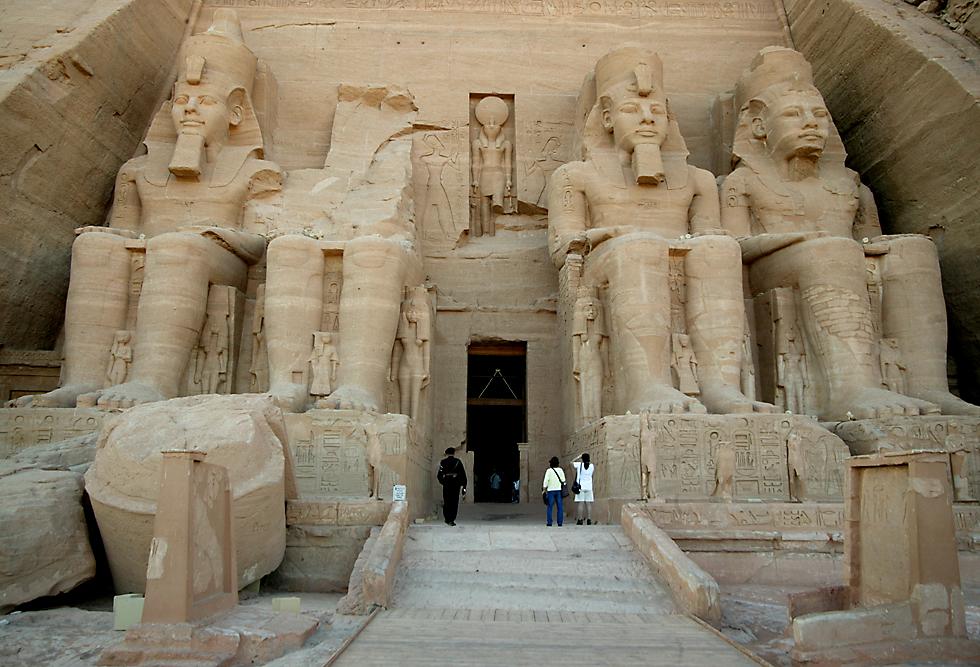Temples, wives and moving big things

Monster Moves is a TV program about moving really big things – trains, houses and even Egyptian temples. About a year ago we saw an episode about moving the Temple at Abu Simbel to save it from the rising waters caused when the Egyptians dammed the Nile at Aswan. It really captured all of our imagination and so a visit to Abu Simbel was an absolute must for us.
The flight from Aswan to Abu Simbel takes about 45 minutes in a small plane and is a great way to get a perspective on the desert and, then, on the enormous Lake Nasar created by the Aswan Dam.
The Temple itself is one of the first real pieces of propaganda in the world. Ramases II had it built to push the fact that he was a living god and to remind the local tribes that he had beaten them into submission once and was able to do the same again any time they got thoughts above their station. The facade is enormous and imposing, but inside is intricate and marvellous. There are many beautifully rendered scenes of Rameses doing heroic things and hobnobbing with other, better established, gods.
It does not take long to understand why the enormous effort put into saving this place was undertaken. And it was an enormous effort. The temple was not free-standing; it was carved into the side of a hill. So they had to chop the entire hill up into bits and then rebuild it 50m higher up the hillside – all the while maintaining its aspect and not damaging the intricate carvings. The entire job was done at speed in the face of the rising waters of the lake. Now it’s possible to see the joins, but only if you really look for them.
One of the features of the temple is that sunlight pierces to the back of the temple only twice a year, at sunrise on the 21st of February and the 21st of October. In addition, of the four statues built right at the back of the temple only three of them get lit by that beam of sunlight – the fourth is the god of the underworld and stays in darkness. Making sure the builders’ precise orientation was maintained was important in saving the Temple. We were quite saddened to see that spotlights at the back of the temple light all four gods. It wouldn’t have taken much to leave the poor god of the underworld in the dark as intended.
In a similar vein we noticed, when we visited the Egyptian Museum a few days ago, two statues that had stood guard over Tutankhamen’s tomb for millennia. They are large and imposing guardians and for all that time they’d stood, as they’d been designed, facing each other. Now for some inexplicable reason they flank a door in the Museum and face outwards so they can no longer look towards each other. We couldn’t help but think that would sadden them. I know we’re giving too much life to a carving, but after a few thousand years of putting in the hard-yards they do deserve some sort of respect.
There are actually two temples at Abu Simbel. Just to the side of the main one is a slightly smaller one dedicated to Nefertari – Rameses II’s favourite wife. Just how favoured she was, was indicated by the fact she not only got a temple to herself, she was depicted in a statue the same size as Rameses’. No other Pharaoh’s wife in history got to be higher than the Pharaohs’ knee. Ramases actually had 57 wives and something like 170 children. He was very warlike and after conquering tribes, peoples or countries he would marry a local princess to seal the peace. He ruled for over 60 years and so amassed an enormous collection of both bits of empire and princesses. Nefertari – who should not be confused with Nefertiti – probably deserves a temple for getting herself to the front of that crowd.
We wished we could have stayed longer at Abu Simbel but the flights make for a quick turn round, especially with the vast amount of security theatre of which Jennifer will write separately. Unfortunately the flight back was bumpy and Callum greeted landing in his usual vomitous fashion. But even after that we all agreed the visit had been entirely worthwhile and lived up to our monstrous expectations.
You’ll have to come and visit the DeBod Temple which is about 400m from my house in Madrid.
It isn’t as spectactular as the Abu Simbel temple sounds but also was moved to save it from the rising waters of the Aswan Dam.
They Egyptian government gave it to Spain in recognition of their assistance in building the dam itself.